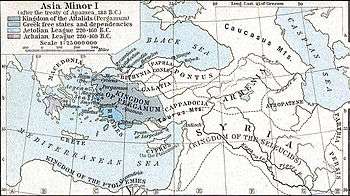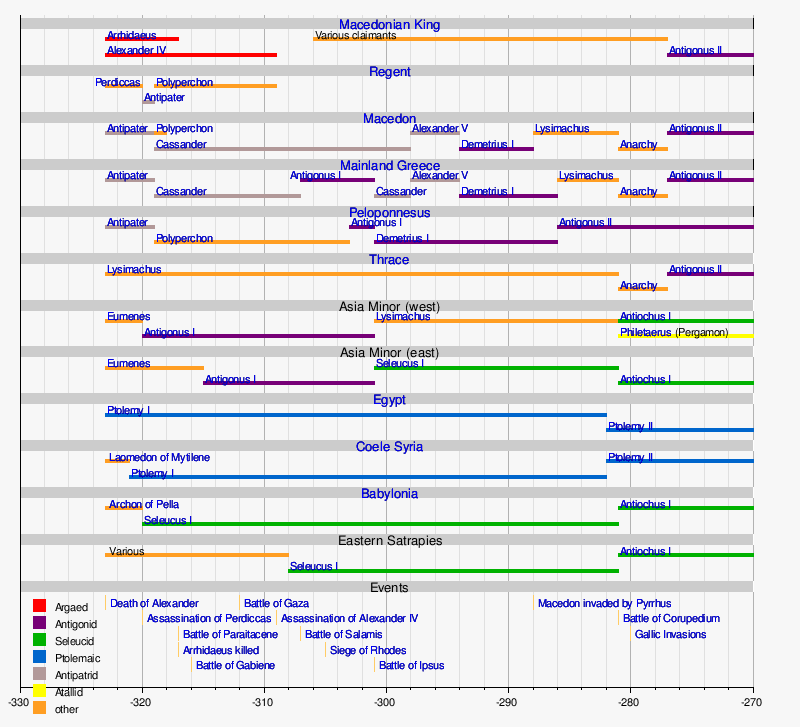Attalid dynasty
| Kingdom of Pergamon | ||||||||||
| ||||||||||
|
| ||||||||||
 | ||||||||||
| Capital | Pergamon | |||||||||
| Languages | Greek Lycian, Carian, Lydian | |||||||||
| Government | Monarchy | |||||||||
| King | ||||||||||
| • | 282–263 BC | Philetaerus | ||||||||
| • | 263–241 BC | Eumenes I | ||||||||
| • | 241–197 BC | Attalus I | ||||||||
| • | 197–159 BC | Eumenes II | ||||||||
| • | 160–138 BC | Attalus II | ||||||||
| • | 138–133 BC | Attalus III | ||||||||
| • | 133–129 BC | Eumenes III | ||||||||
| Historical era | Hellenistic period | |||||||||
| • | Philetaerus takes control of the city of Pergamon | 282 BC | ||||||||
| • | Attalus III bequeathed the kingdom to the Roman Republic | 133 BC | ||||||||
| ||||||||||
The Attalid dynasty (/ˈætəlᵻd/; Greek: Δυναστεία των Ατταλιδών) was a Hellenistic dynasty that ruled the city of Pergamon after the death of Lysimachus, a general of Alexander the Great. The Attalid kingdom was the rump state left after the collapse of the Lysimachian Empire. One of Lysimachus' officers, Philetaerus, took control of the city in 282 BC. The later Attalids were descended from his father and they expanded the city into a kingdom. Attalus I proclaimed himself King in the 230s BC, following his victories over the Galatians. The Attalids ruled Pergamon until Attalus III bequeathed the kingdom to the Roman Republic in 133 BC[1] to avoid a likely succession crisis. A war with Eumenes III resulted in the creation of Roman province of Asia over much of the territory.
On the interior of the Pergamon Altar is a frieze depicting the life of Telephus, son of Herakles, whom the ruling Attalid dynasty associated with its city and utilized to claim descent from the Olympians. Pergamon, having entered the Greek world much later than its counterparts to the west, could not boast the same divine heritage as older city-states and retroactively had to cultivate its place in Greek mythology.
Dynasty of Pergamon
- Philetaerus (282–263 BC)
- Eumenes I (263–241 BC)
- Attalus I Soter (241–197 BC)
- Eumenes II (197–159 BC)
- Attalus II Philadelphus (160–138 BC)
- Attalus III (138–133 BC)
- Eumenes III Aristonicus (pretender, 133–129 BC)
Genealogy
| Attalus | Boa | ||||||||||||||||||||||||||||||||||||||||||||||||||
| Philetaerus | Eumenes | Satyra | Attalus | ||||||||||||||||||||||||||||||||||||||||||||||||
| Eumenes I | Philetaerus (?) | Attalus | Antiochis | Eumenes (?) | |||||||||||||||||||||||||||||||||||||||||||||||
| Attalus I | Apollonis | ||||||||||||||||||||||||||||||||||||||||||||||||||
| Stratonice | Eumenes II | (?) | Attalus II | Philetaerus | Athenaeus | ||||||||||||||||||||||||||||||||||||||||||||||
| Attalus III | Eumenes III | ||||||||||||||||||||||||||||||||||||||||||||||||||
Namesakes
- Attalea in Lydia, Roman city, former diocese and present Latin Catholic titular bishopric; now Yanantepe
- Attalea in Pamphylia, Roman city, former diocese and present Latin Catholic titular bishopric; now Antalya
Notes
- ↑ Shipley (2000) pp. 318-319.
Sources
- Shipley (2000). The Greek World After Alexander, 323-30 B.C.
- Hansen, Esther V. (1971). The Attalids of Pergamon. Ithaca, New York: Cornell University Press; London: Cornell University Press Ltd. ISBN 0-8014-0615-3.
- Kosmetatou, Elizabeth (2003) "The Attalids of Pergamon," in Andrew Erskine, ed., A Companion to the Hellenistic World. Oxford: Blackwell: pp. 159–174. ISBN 1-4051-3278-7. text
External links
-
 Media related to Attalid dynasty at Wikimedia Commons
Media related to Attalid dynasty at Wikimedia Commons

